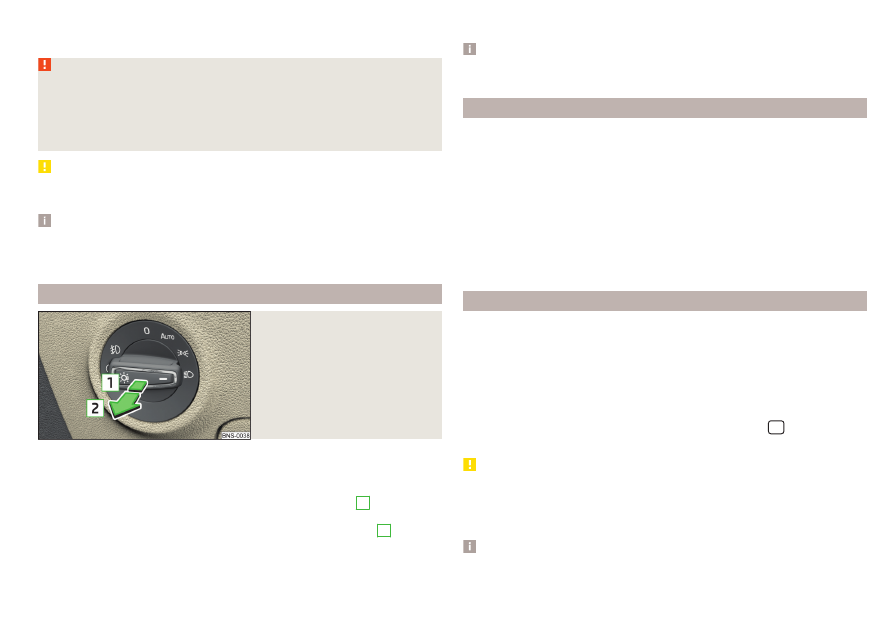Skoda Kodiaq (2019 year). Instruction - part 5

If there is a fault, the error message will appear in the instrument cluster dis-
play. Seek help from a specialist garage.
WARNING
The system is used only for support, thus the driver is not released from his
obligation to instructionly adjust the main or low beam according to the given
ambient conditions (e.g. in unfavourable lighting and weather conditions, as
when passing poorly lit road users, if necessary, when the area in front of
the sensor is covered by an obstacle).
CAUTION
Do not cover the sensor and keep the front screen clean - system functionality
can be impaired.
Note
The setting for the high-beam assistant in Infotainment is stored (depending
on the Infotainment type) in the active user account for personalisation
.
Fog lights/rear fog light
Fig. 72
Light switch – switch on front
and rear fog lights
Switching on the fog lights/rear fog lights is possible under the following
conditions.
The lights switch is in position , or
.
›
To switch on the fog lights, turn the light switch to position
1
; the warning
light
illuminates in the instrument cluster.
›
To switch on the rear fog lights, pull the light switch to position
2
; the
warning light
illuminates in the instrument cluster.
If the vehicle is not equipped with fog lights, the rear fog lights can be switch-
ed on by pulling the light switch to the only possible setting.
Switch off the fog lights/rear fog lights in reverse order.
Note
If an accessory is connected to the trailer socket, the rear fog lamp does not
light up on the vehicle.
function CORNER
The CORNER function automatically switches on the fog lights on the respec-
tive side of the vehicle (e.g. when cornering or steering), if the following condi-
tions are fulfilled.
The turn signal is turned on or the front wheels are severely locked (in the
event of conflict between the two versions, has turn signal has the higher
priority).
The vehicle speed is below 40 km/h.
The low beam is switched on.
The fog lights are not switched on.
The two fog lights are switched on when you shift into the reverse gear.
COMING HOME / LEAVING HOME
The function COMING HOME ensures that the vehicle's environment is illumi-
nated after switching off the ignition and opening the driver's door.
The function LEAVING HOME ensures that the vehicle's environment is illumi-
nated after unlocking the vehicle with the radio remote control unit.
The function switches the light on only if there is poorer visibility and the light
switch is in the position .
The two functions can be used in Infotainment in the menu
/ → → Light
(activated/deactivated and adjusted).
CAUTION
■
Poorer visibility is evaluated by a sensor mounted below the windscreen in
the holder of the rear-view mirror. Do not cover the sensor - the system can
be affected.
■
If this option is always enabled, then the battery is heavily loaded.
Note
The setting of the two functions is stored (depending on the Infotainment
type) in the active user account personalisation
.
77
Lights and visibility